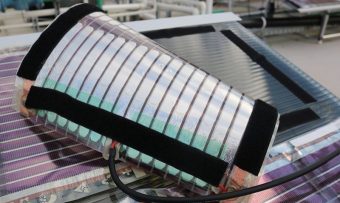
A team of researchers headed by Professor Paul Dastoor at the University of Newcastle in Australia has begun testing printed solar panels. The experimental panels are made by printing a special electronic ink onto clear laminated sheets as thin as a single piece of paper using conventional printing presses. The sheets have been installed using velcro strips and cover an area of about 100 square meters. This represents the first large-scale test of a project Dastoor and his team have been working on for more than 15 years.
“This installation brings us closer than we have ever been to making this technology a reality. It will help to determine the lifespan of the material and provide half-hourly feedback on the performance of the system,” says Professor Dastoor. “There are just three demonstration sites at this scale that we know of anywhere in the world, so Australia has joined quite an elite group of global leaders poised to make this technology a commercial reality.”
The printed solar panels are light and flexible and can be literally rolled out anywhere there is a flat surface. Dastoor says the cost of producing the printed panels is about $10 per square meter. “The low cost and speed at which this technology can be deployed is exciting, particularly in the current Australian energy context where we need to find solutions, and quickly, to reduce demand on base-load power,” Dastoor says.
“No other renewable energy solution can be manufactured as quickly. On our lab-scale printer we can easily produce hundreds of meters of material per day. On a commercial scale printer, this would increase to kilometres. If you had just ten of these printers operating around the clock we could print enough material to deliver power to 1000 homes per day,” he says.
Dastoor says the printed solar panels are more sensitive to low light levels, which means they produce a more constant flow of power on cloudy days. They can even produce a small amount of energy from moonlight. Their light weight and ease of installation make them an ideal choice for bringing electricity to areas hit by natural disasters such as earthquakes and storms.
The test at the University of Newcastle will allow researchers to monitor a large area of panels under real world conditions for the first time. If successful, the proof of concept demonstration could inspire a new service delivery model, removing key barriers to solar uptake in the community.
“It might operate like a telephone line, where customers choose a service plan based on their usage requirements but do not need to outlay the physical cost of the line installation and associated upkeep. The system is owned, maintained and updated by the provider and customers could scale their plan up or down as their requirements change,” said Professor Dastoor. “By reinventing the delivery model we remove the need for initial lump sum outlays, overcoming the key barrier to community uptake and ensuring that the science actually ends up on our rooftops,” he says.
Dastoor has not revealed any specifics about the conversion rate of his printed solar panels or how they compare in electricity production to conventional crystalline panels.
Source: cleantechnica.com



